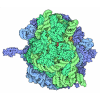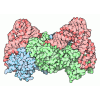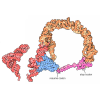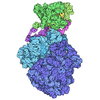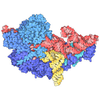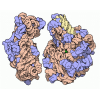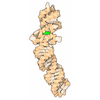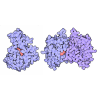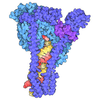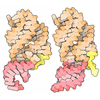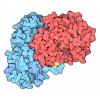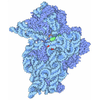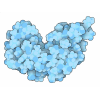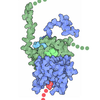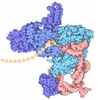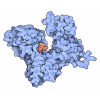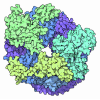[English] 日本語
 Yorodumi
Yorodumi- PDB-8pj4: Structure of human 48S translation initiation complex after eIF5 ... -
+ Open data
Open data
- Basic information
Basic information
| Entry | Database: PDB / ID: 8pj4 | |||||||||
|---|---|---|---|---|---|---|---|---|---|---|
| Title | Structure of human 48S translation initiation complex after eIF5 release (48S-4) | |||||||||
 Components Components |
| |||||||||
 Keywords Keywords | RIBOSOME / TRANSLATION / initiation / 48S / eIF / human / eukaryotic / factor / codon / scanning / closed | |||||||||
| Function / homology |  Function and homology information Function and homology informationpositive regulation of mRNA binding / translation initiation ternary complex / regulation of translation in response to endoplasmic reticulum stress / glial limiting end-foot / HRI-mediated signaling / viral translational termination-reinitiation / response to manganese-induced endoplasmic reticulum stress / Cellular response to mitochondrial stress / positive regulation of type B pancreatic cell apoptotic process / eukaryotic translation initiation factor 3 complex, eIF3e ...positive regulation of mRNA binding / translation initiation ternary complex / regulation of translation in response to endoplasmic reticulum stress / glial limiting end-foot / HRI-mediated signaling / viral translational termination-reinitiation / response to manganese-induced endoplasmic reticulum stress / Cellular response to mitochondrial stress / positive regulation of type B pancreatic cell apoptotic process / eukaryotic translation initiation factor 3 complex, eIF3e / Response of EIF2AK1 (HRI) to heme deficiency / Recycling of eIF2:GDP / negative regulation of translational initiation in response to stress / cap-dependent translational initiation / methionyl-initiator methionine tRNA binding / eukaryotic translation initiation factor 3 complex, eIF3m / PERK-mediated unfolded protein response / PERK regulates gene expression / IRES-dependent viral translational initiation / response to kainic acid / translation reinitiation / eukaryotic translation initiation factor 2 complex / eukaryotic translation initiation factor 3 complex / formation of cytoplasmic translation initiation complex / cytoplasmic translational initiation / multi-eIF complex / regulation of translational initiation in response to stress / eukaryotic 43S preinitiation complex / translation factor activity, RNA binding / mRNA cap binding / formation of translation preinitiation complex / eukaryotic 48S preinitiation complex / negative regulation of endoplasmic reticulum unfolded protein response / oxidized pyrimidine DNA binding / response to TNF agonist / positive regulation of base-excision repair / positive regulation of respiratory burst involved in inflammatory response / positive regulation of intrinsic apoptotic signaling pathway in response to DNA damage / positive regulation of gastrulation / protein tyrosine kinase inhibitor activity / positive regulation of endodeoxyribonuclease activity / IRE1-RACK1-PP2A complex / nucleolus organization / positive regulation of Golgi to plasma membrane protein transport / TNFR1-mediated ceramide production / negative regulation of DNA repair / negative regulation of RNA splicing / metal-dependent deubiquitinase activity / supercoiled DNA binding / neural crest cell differentiation / protein-synthesizing GTPase / NF-kappaB complex / nuclear-transcribed mRNA catabolic process, nonsense-mediated decay / cysteine-type endopeptidase activator activity involved in apoptotic process / regulation of translational initiation / oxidized purine DNA binding / positive regulation of ubiquitin-protein transferase activity / negative regulation of intrinsic apoptotic signaling pathway in response to hydrogen peroxide / regulation of establishment of cell polarity / negative regulation of bicellular tight junction assembly / ubiquitin-like protein conjugating enzyme binding / negative regulation of phagocytosis / rRNA modification in the nucleus and cytosol / Formation of the ternary complex, and subsequently, the 43S complex / erythrocyte homeostasis / cytoplasmic side of rough endoplasmic reticulum membrane / laminin receptor activity / negative regulation of ubiquitin protein ligase activity / protein kinase A binding / ion channel inhibitor activity / Ribosomal scanning and start codon recognition / pigmentation / Translation initiation complex formation / positive regulation of mitochondrial depolarization / positive regulation of T cell receptor signaling pathway / negative regulation of Wnt signaling pathway / fibroblast growth factor binding / monocyte chemotaxis / positive regulation of activated T cell proliferation / negative regulation of translational frameshifting / TOR signaling / Protein hydroxylation / BH3 domain binding / SARS-CoV-1 modulates host translation machinery / regulation of adenylate cyclase-activating G protein-coupled receptor signaling pathway / iron-sulfur cluster binding / regulation of cell division / cellular response to ethanol / mTORC1-mediated signalling / Peptide chain elongation / Selenocysteine synthesis / Formation of a pool of free 40S subunits / positive regulation of intrinsic apoptotic signaling pathway by p53 class mediator / endonucleolytic cleavage to generate mature 3'-end of SSU-rRNA from (SSU-rRNA, 5.8S rRNA, LSU-rRNA) / Eukaryotic Translation Termination / ubiquitin ligase inhibitor activity / positive regulation of GTPase activity / Response of EIF2AK4 (GCN2) to amino acid deficiency / SRP-dependent cotranslational protein targeting to membrane / negative regulation of ubiquitin-dependent protein catabolic process Similarity search - Function | |||||||||
| Biological species |  Homo sapiens (human) Homo sapiens (human) | |||||||||
| Method | ELECTRON MICROSCOPY / single particle reconstruction / cryo EM / Resolution: 3.2 Å | |||||||||
 Authors Authors | Petrychenko, V. / Yi, S.-H. / Liedtke, D. / Peng, B.Z. / Rodnina, M.V. / Fischer, N. | |||||||||
| Funding support |  Germany, 2items Germany, 2items
| |||||||||
 Citation Citation |  Journal: Nat Struct Mol Biol / Year: 2025 Journal: Nat Struct Mol Biol / Year: 2025Title: Structural basis for translational control by the human 48S initiation complex. Authors: Valentyn Petrychenko / Sung-Hui Yi / David Liedtke / Bee-Zen Peng / Marina V Rodnina / Niels Fischer /  Abstract: The selection of an open reading frame (ORF) for translation of eukaryotic mRNA relies on remodeling of the scanning 48S initiation complex into an elongation-ready 80S ribosome. Using cryo-electron ...The selection of an open reading frame (ORF) for translation of eukaryotic mRNA relies on remodeling of the scanning 48S initiation complex into an elongation-ready 80S ribosome. Using cryo-electron microscopy, we visualize the key commitment steps orchestrating 48S remodeling in humans. The mRNA Kozak sequence facilitates mRNA scanning in the 48S open state and stabilizes the 48S closed state by organizing the contacts of eukaryotic initiation factors (eIFs) and ribosomal proteins and by reconfiguring mRNA structure. GTPase-triggered large-scale fluctuations of 48S-bound eIF2 facilitate eIF5B recruitment, transfer of initiator tRNA from eIF2 to eIF5B and the release of eIF5 and eIF2. The 48S-bound multisubunit eIF3 complex controls ribosomal subunit joining by coupling eIF exchange to gradual displacement of the eIF3c N-terminal domain from the intersubunit interface. These findings reveal the structural mechanism of ORF selection in human cells and explain how eIF3 could function in the context of the 80S ribosome. #1: Journal: Protein Sci / Year: 2018 Title: UCSF ChimeraX: Meeting modern challenges in visualization and analysis. Authors: Thomas D Goddard / Conrad C Huang / Elaine C Meng / Eric F Pettersen / Gregory S Couch / John H Morris / Thomas E Ferrin /  Abstract: UCSF ChimeraX is next-generation software for the visualization and analysis of molecular structures, density maps, 3D microscopy, and associated data. It addresses challenges in the size, scope, and ...UCSF ChimeraX is next-generation software for the visualization and analysis of molecular structures, density maps, 3D microscopy, and associated data. It addresses challenges in the size, scope, and disparate types of data attendant with cutting-edge experimental methods, while providing advanced options for high-quality rendering (interactive ambient occlusion, reliable molecular surface calculations, etc.) and professional approaches to software design and distribution. This article highlights some specific advances in the areas of visualization and usability, performance, and extensibility. ChimeraX is free for noncommercial use and is available from http://www.rbvi.ucsf.edu/chimerax/ for Windows, Mac, and Linux. | |||||||||
| History |
|
- Structure visualization
Structure visualization
| Structure viewer | Molecule:  Molmil Molmil Jmol/JSmol Jmol/JSmol |
|---|
- Downloads & links
Downloads & links
- Download
Download
| PDBx/mmCIF format |  8pj4.cif.gz 8pj4.cif.gz | 3.1 MB | Display |  PDBx/mmCIF format PDBx/mmCIF format |
|---|---|---|---|---|
| PDB format |  pdb8pj4.ent.gz pdb8pj4.ent.gz | Display |  PDB format PDB format | |
| PDBx/mmJSON format |  8pj4.json.gz 8pj4.json.gz | Tree view |  PDBx/mmJSON format PDBx/mmJSON format | |
| Others |  Other downloads Other downloads |
-Validation report
| Summary document |  8pj4_validation.pdf.gz 8pj4_validation.pdf.gz | 1.9 MB | Display |  wwPDB validaton report wwPDB validaton report |
|---|---|---|---|---|
| Full document |  8pj4_full_validation.pdf.gz 8pj4_full_validation.pdf.gz | 1.9 MB | Display | |
| Data in XML |  8pj4_validation.xml.gz 8pj4_validation.xml.gz | 278.5 KB | Display | |
| Data in CIF |  8pj4_validation.cif.gz 8pj4_validation.cif.gz | 471.4 KB | Display | |
| Arichive directory |  https://data.pdbj.org/pub/pdb/validation_reports/pj/8pj4 https://data.pdbj.org/pub/pdb/validation_reports/pj/8pj4 ftp://data.pdbj.org/pub/pdb/validation_reports/pj/8pj4 ftp://data.pdbj.org/pub/pdb/validation_reports/pj/8pj4 | HTTPS FTP |
-Related structure data
| Related structure data |  17699MC  8pj1C  8pj2C  8pj3C  8pj5C  8pj6C 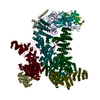 8rg0C M: map data used to model this data C: citing same article ( |
|---|---|
| Similar structure data | Similarity search - Function & homology  F&H Search F&H Search |
- Links
Links
- Assembly
Assembly
| Deposited unit | 
|
|---|---|
| 1 |
|
- Components
Components
-Eukaryotic translation initiation factor ... , 16 types, 16 molecules 01234568oqrtuvxy
| #1: Protein | Mass: 139079.078 Da / Num. of mol.: 1 / Source method: isolated from a natural source / Source: (natural)  Homo sapiens (human) / References: UniProt: O60841, protein-synthesizing GTPase Homo sapiens (human) / References: UniProt: O60841, protein-synthesizing GTPase |
|---|---|
| #2: Protein | Mass: 92593.414 Da / Num. of mol.: 1 / Source method: isolated from a natural source / Source: (natural)  Homo sapiens (human) / References: UniProt: P55884 Homo sapiens (human) / References: UniProt: P55884 |
| #3: Protein | Mass: 36543.773 Da / Num. of mol.: 1 / Source method: isolated from a natural source / Source: (natural)  Homo sapiens (human) / References: UniProt: Q13347 Homo sapiens (human) / References: UniProt: Q13347 |
| #4: Protein | Mass: 25083.619 Da / Num. of mol.: 1 / Source method: isolated from a natural source / Source: (natural)  Homo sapiens (human) / References: UniProt: Q9UBQ5 Homo sapiens (human) / References: UniProt: Q9UBQ5 |
| #5: Protein | Mass: 37593.645 Da / Num. of mol.: 1 / Source method: isolated from a natural source / Source: (natural)  Homo sapiens (human) / References: UniProt: O00303, ubiquitinyl hydrolase 1 Homo sapiens (human) / References: UniProt: O00303, ubiquitinyl hydrolase 1 |
| #6: Protein | Mass: 66803.734 Da / Num. of mol.: 1 / Source method: isolated from a natural source / Source: (natural)  Homo sapiens (human) / References: UniProt: Q9Y262 Homo sapiens (human) / References: UniProt: Q9Y262 |
| #7: Protein | Mass: 42555.832 Da / Num. of mol.: 1 / Source method: isolated from a natural source / Source: (natural)  Homo sapiens (human) / References: UniProt: Q7L2H7 Homo sapiens (human) / References: UniProt: Q7L2H7 |
| #9: Protein | Mass: 39979.277 Da / Num. of mol.: 1 / Source method: isolated from a natural source / Source: (natural)  Homo sapiens (human) / References: UniProt: O15372 Homo sapiens (human) / References: UniProt: O15372 |
| #45: Protein | Mass: 35662.016 Da / Num. of mol.: 1 / Source method: isolated from a natural source / Source: (natural)  Homo sapiens (human) / References: UniProt: O75821 Homo sapiens (human) / References: UniProt: O75821 |
| #46: Protein | Mass: 16488.449 Da / Num. of mol.: 1 Source method: isolated from a genetically manipulated source Source: (gene. exp.)  Homo sapiens (human) / Gene: EIF1AX, EIF1A, EIF4C / Production host: Homo sapiens (human) / Gene: EIF1AX, EIF1A, EIF4C / Production host:  |
| #47: Protein | Mass: 36161.180 Da / Num. of mol.: 1 / Source method: isolated from a natural source / Source: (natural)  Homo sapiens (human) / References: UniProt: P05198 Homo sapiens (human) / References: UniProt: P05198 |
| #48: Protein | Mass: 51178.406 Da / Num. of mol.: 1 / Source method: isolated from a natural source / Source: (natural)  Homo sapiens (human) / References: UniProt: P41091, protein-synthesizing GTPase Homo sapiens (human) / References: UniProt: P41091, protein-synthesizing GTPase |
| #49: Protein | Mass: 166903.781 Da / Num. of mol.: 1 / Source method: isolated from a natural source / Source: (natural)  Homo sapiens (human) / References: UniProt: Q14152 Homo sapiens (human) / References: UniProt: Q14152 |
| #50: Protein | Mass: 52281.633 Da / Num. of mol.: 1 / Source method: isolated from a natural source / Source: (natural)  Homo sapiens (human) / References: UniProt: P60228 Homo sapiens (human) / References: UniProt: P60228 |
| #52: Protein | Mass: 64060.758 Da / Num. of mol.: 1 / Source method: isolated from a natural source / Source: (natural)  Homo sapiens (human) / References: UniProt: O15371 Homo sapiens (human) / References: UniProt: O15371 |
| #53: Protein | Mass: 105503.945 Da / Num. of mol.: 1 / Source method: isolated from a natural source / Source: (natural)  Homo sapiens (human) / References: UniProt: Q99613 Homo sapiens (human) / References: UniProt: Q99613 |
-RNA chain , 3 types, 3 molecules 7Aw
| #8: RNA chain | Mass: 82412.445 Da / Num. of mol.: 1 Source method: isolated from a genetically manipulated source Source: (gene. exp.)  Homo sapiens (human) / Production host: Homo sapiens (human) / Production host:  |
|---|---|
| #11: RNA chain | Mass: 603245.500 Da / Num. of mol.: 1 / Source method: isolated from a natural source / Source: (natural)  Homo sapiens (human) Homo sapiens (human) |
| #51: RNA chain | Mass: 24231.510 Da / Num. of mol.: 1 Source method: isolated from a genetically manipulated source Source: (gene. exp.)  Homo sapiens (human) / Production host: Homo sapiens (human) / Production host:  |
-Protein/peptide , 1 types, 1 molecules 9
| #10: Protein/peptide | Mass: 3473.451 Da / Num. of mol.: 1 / Source method: isolated from a natural source / Source: (natural)  Homo sapiens (human) / References: UniProt: P62945 Homo sapiens (human) / References: UniProt: P62945 |
|---|
+40S ribosomal protein ... , 30 types, 30 molecules BCDEGHIJKLMNOPQRSTVYZabdefhimn
-Protein , 3 types, 3 molecules Fck
| #16: Protein | Mass: 14383.659 Da / Num. of mol.: 1 / Source method: isolated from a natural source / Source: (natural)  Homo sapiens (human) / References: UniProt: P62861 Homo sapiens (human) / References: UniProt: P62861 |
|---|---|
| #36: Protein | Mass: 35115.652 Da / Num. of mol.: 1 / Source method: isolated from a natural source / Source: (natural)  Homo sapiens (human) / References: UniProt: P63244 Homo sapiens (human) / References: UniProt: P63244 |
| #42: Protein | Mass: 18004.041 Da / Num. of mol.: 1 / Source method: isolated from a natural source / Source: (natural)  Homo sapiens (human) / References: UniProt: P62979 Homo sapiens (human) / References: UniProt: P62979 |
-Non-polymers , 4 types, 93 molecules 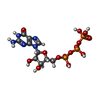






| #54: Chemical | ChemComp-GTP / | ||
|---|---|---|---|
| #55: Chemical | ChemComp-NA / | ||
| #56: Chemical | ChemComp-MG / #57: Chemical | |
-Details
| Has ligand of interest | N |
|---|---|
| Has protein modification | Y |
-Experimental details
-Experiment
| Experiment | Method: ELECTRON MICROSCOPY |
|---|---|
| EM experiment | Aggregation state: PARTICLE / 3D reconstruction method: single particle reconstruction |
- Sample preparation
Sample preparation
| Component | Name: Human 48S initiation complex 40S-eIF1A-eIF2-eIF3-eIF5B-tRNA-Met-mRNA Type: RIBOSOME / Entity ID: #1-#53 / Source: RECOMBINANT | ||||||||||||||||||||||||||||||||||||||||
|---|---|---|---|---|---|---|---|---|---|---|---|---|---|---|---|---|---|---|---|---|---|---|---|---|---|---|---|---|---|---|---|---|---|---|---|---|---|---|---|---|---|
| Source (natural) | Organism:  Homo sapiens (human) Homo sapiens (human) | ||||||||||||||||||||||||||||||||||||||||
| Source (recombinant) | Organism:  Homo sapiens (human) Homo sapiens (human) | ||||||||||||||||||||||||||||||||||||||||
| Buffer solution | pH: 7.5 | ||||||||||||||||||||||||||||||||||||||||
| Buffer component |
| ||||||||||||||||||||||||||||||||||||||||
| Specimen | Embedding applied: NO / Shadowing applied: NO / Staining applied: NO / Vitrification applied: YES | ||||||||||||||||||||||||||||||||||||||||
| Vitrification | Instrument: HOMEMADE PLUNGER / Cryogen name: ETHANE / Details: Manual blotting & plunge-freezing |
- Electron microscopy imaging
Electron microscopy imaging
| Experimental equipment |  Model: Titan Krios / Image courtesy: FEI Company |
|---|---|
| Microscopy | Model: FEI TITAN KRIOS |
| Electron gun | Electron source:  FIELD EMISSION GUN / Accelerating voltage: 300 kV / Illumination mode: SPOT SCAN FIELD EMISSION GUN / Accelerating voltage: 300 kV / Illumination mode: SPOT SCAN |
| Electron lens | Mode: BRIGHT FIELD / Nominal magnification: 59000 X / Nominal defocus max: 2500 nm / Nominal defocus min: 200 nm |
| Specimen holder | Cryogen: NITROGEN / Specimen holder model: FEI TITAN KRIOS AUTOGRID HOLDER |
| Image recording | Average exposure time: 1.5 sec. / Electron dose: 45 e/Å2 / Film or detector model: FEI FALCON III (4k x 4k) |
| EM imaging optics | Spherical aberration corrector: Electron-optical aberrations were corrected using a CETCOR Cs-corrector (CEOS, Heidelberg) aligned with the CETCORPLUS 4.6.9 software package (CEOS, Heidelberg). |
- Processing
Processing
| EM software |
| ||||||||||||||||||||||||||||||||||||
|---|---|---|---|---|---|---|---|---|---|---|---|---|---|---|---|---|---|---|---|---|---|---|---|---|---|---|---|---|---|---|---|---|---|---|---|---|---|
| CTF correction | Type: PHASE FLIPPING AND AMPLITUDE CORRECTION | ||||||||||||||||||||||||||||||||||||
| 3D reconstruction | Resolution: 3.2 Å / Resolution method: FSC 0.143 CUT-OFF / Num. of particles: 46318 / Symmetry type: POINT |
 Movie
Movie Controller
Controller








 PDBj
PDBj